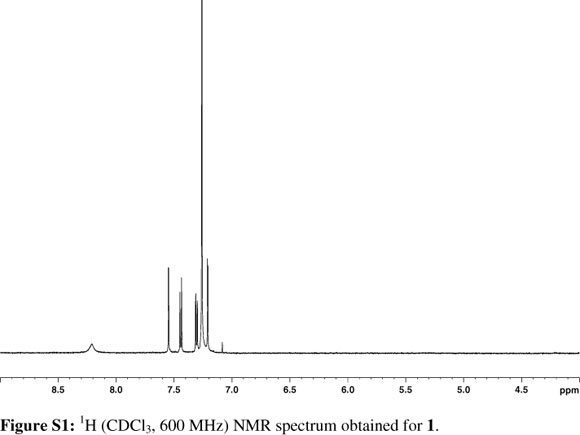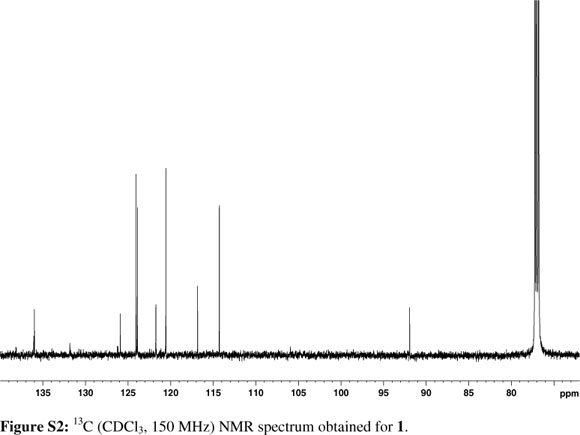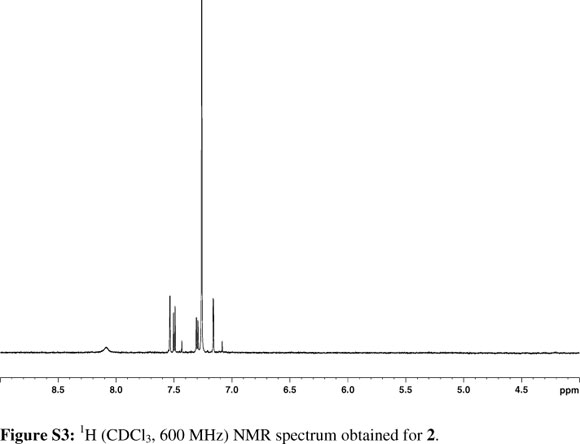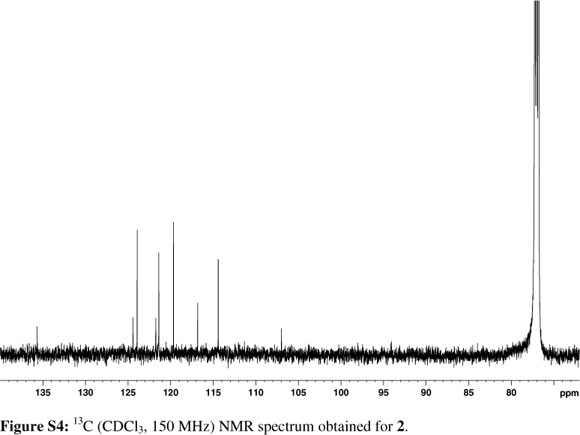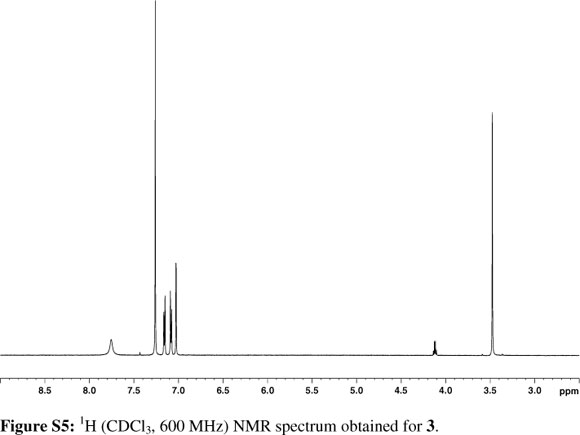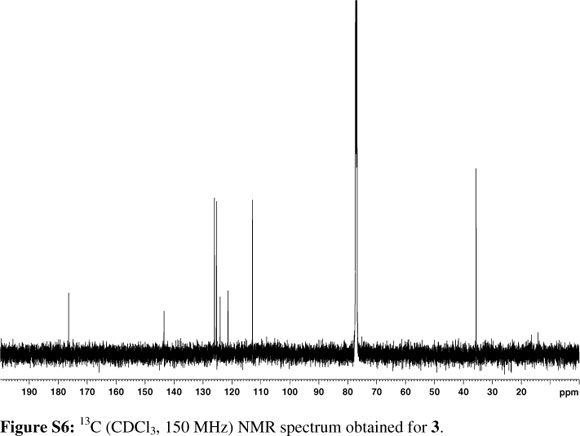Serviços Personalizados
Artigo
Indicadores
Links relacionados
-
 Citado por Google
Citado por Google -
 Similares em Google
Similares em Google
Compartilhar
South African Journal of Chemistry
versão On-line ISSN 1996-840X
versão impressa ISSN 0379-4350
S.Afr.j.chem. (Online) vol.66 Durban Ago. 2013
RESEARCH ARTICLE
Halogenated oxindole and indoles from the South African marine ascidian Distaplia skoogi
Candice L. BromleyI, *; Shirley Parker-NanceII, III; Jo-Anne de la MareIV; Adrienne L. EdkinsIV; Denzil R. BeukesV; Michael T. Davies-ColemanVI
IDepartment of Chemistry, Rhodes University, Grahamstown, 6140, South Africa
IICentre for African Conservation Ecology, Department of Zoology, Nelson Mandela Metropolitan University, P.O. Box 77000, Port Elizabeth, 6031, South Africa
IIISouth African Institute for Aquatic Biodiversity, Private Bag 1015, Grahamstown, 6140, South Africa
IVBiomedical Biotechnology Research Unit, Department of Biochemistry, Microbiology and Biotechnology, Rhodes University, Grahamstown, 6140, South Africa
VDivision of Pharmaceutical Chemistry, Faculty of Pharmacy, Rhodes University, Grahamstown, 6140, South Africa
VIDepartment of Chemistry, University of the Western Cape, Bellville, 7535, South Africa
ABSTRACT
The known 3,6-dibromoindole (1), 6-bromo-3-chloroindole (2) and 6-bromo-2-oxindole (3) were isolated from the marine ascidian (sea squirt) Distapia skoogi collected from Algoa Bay, South Africa. Standard spectroscopic techniques were used to elucidate the structures of 1-3. All three compounds were found to be moderately cytotoxic to metastatic MDA-MB-231 breast cancer cells.
Keywords: Distaplia skoogi, ascidian, indole, oxindole.
1. Introduction
Ascidians, also known as sea squirts or Tunicates, are a diverse group of filter feeding marine invertebrates, which have proven over the last four decades to be a rich source of bioactive alkaloid metabolites with potential medicinal properties.1 Most notable amongst these medicinally important ascidian alkaloids, are trabectedin (Yondelis®) isolated from Ecteinascidia turbinata and plitidepsin (Aplidin®) isolated from Aplidium albicans.2 Yondelis® has been available in Europe since 2007 for the treatment of soft tissue sarcomas and is the first drug to enter the market to treat this form of cancer in 20 years.2-4 Aplidin® is currently in phase II clinical trials against various cancers, e.g. multiple myeloma, metastatic melanoma, prostate cancer, bladder cancer, non-Hodgkin's lymphoma and acute lymphoblastic leukaemia.2,5
This investigation focused on the isolation and bioactivity of the nitrogenous secondary metabolites of the Algoa Bay ascidian, Distaplia skoogi Michaelsen, 1934,6,7 Aplousobranchia: Holozoidae6 (Fig. 1). Algoa Bay is centrally situated within the Agulhas Ecoregion on the Eastern Cape coast of South Africa.8 This area has been recognized for both its species diversity and high endemicity.9-12 The ascidian Distaplia skoogi was collected using SCUBA at a depth of 25 m at White Sands, Algoa Bay, South Africa, in July 2004, and kept frozen until extraction. A methanol extract of D. skoogi was chosen for further investigation from distinctive 2J and 3J,1H-15N correlations observed in the aromatic window (F1= δ -8.0 ppm; F2 = δ 10-50 ppm) of a 15N HMBC NMR experiment used to screen the crude methanol extracts of 22 ascidians collected by SCUBA from Algoa Bay, South Africa in 2004.

To date the only reported natural product isolated from the genus Distaplia is 3,6-dibromoindole (1) which was isolated from D. regina collected in Malakal Harbour, Palau.13
2. Results and Discussion
The lyophilized ascidian, Distaplia skoogi, was sequentially extracted with methanol followed by dichloromethane. The organic extracts were combined, concentrated under reduced pressure and partitioned between ethyl acetate and water. The ethyl acetate partition was subjected to extensive normal phase DIOL HPLC to yield the known compounds 3,6-dibromoindole (1), 6-bromo-3-chloroindole (2) and 6-bromo-2-oxindole (3). Spectroscopic data (MS, NMR and IR) obtained for 1 were consistent with data reported for this compound, isolated from Distaplia regina.13
The molecular formula of 6-bromo-3-chloroindole (2) was established as C8H5N79Br35Cl from the appearance the molecular ion [(M-H)-]at m/z 227.9215 (Δ 0.1 mDa) in the negative ion HRESIMS. A strong band at 3445 cm-1 in the IR spectrum was characteristic of a N-H stretch.14 The 13C NMR and DEPT 135 spectra showed the presence of four aromatic methines (δC 123.9, 121.4, 119.7 and 114.4) and four quaternary carbons (δC 135.7, 124.4, 116.8, and 107.0) with typical heteroaromatic shifts, suggestive of a disubstituted indole system, which would account for the six degrees of unsaturation implied by the molecular formula. The IR spectrum also showed a band at 737 cm-1 suggesting that the indole ring was halogenated.14 That this halogenation comprised both bromine and a chlorine substituents was further supported by the presence of characteristic isotope peaks at m/z 232,230,228 [(M-H)-]in a 3:4:1 ratio in the ESI mass spectrum of 2.
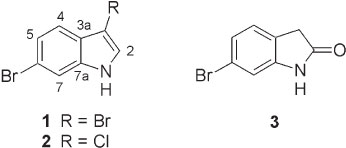
Assignment of the 13C chemical shifts of the two halogenated carbons in 2 was provided from a combination of gHMBC, HSQC and COSY NMR experiments. The position of the bromine and chlorine substituents at C-6 and C-3 on the indole ring in 2 was determined by initially comparing the 13C chemical shift data of 2 with those of 1. The chemical shift of C-6 in 2 (δC 116.8) was consistent with that of C-6 in 1 (<5C116.8), while the downfield shift of C-3 (δC 107.0) in 2 compared to that of C-3 in 1 (δ C 91.9) placed the chlorine substituent at this position in 2.
3-Chloro-6-bromoindole has not previously been isolated from a tunicate species, but it has been shown to be produced, along with compound 1, by marine acorn worms Ptychoderaflava laysanica and Ptychodera flavuI.15 Ascidians (Urochordata: Ascidiacea) and acorn worms (Hemichordata: Enteropneusta) are both marine detritus filter feeders, but phylogenetic analyses of the deuterostome phyla supported by cladistics analysis of morphological data iterates that these groups belong to two different clades.16,17 Therefore the occurrence of 2 in marine organisms from different phyla would possibly suggest a common symbiotic marine microbial source for 2.18-20
The oxindole 3 was isolated as colourless needles with a melting point range of 216-219 °C. The molecular formula of 3 was established as C8H6NO79Br from HRESIMS, m/z 211.9710 (Δ 0.1 mDa) which implied six degrees of unsaturation. The IR spectrum contained a characteristic carbonyl band at 1643 cm-1, as well as a strong band at 3435 cm-1, indicating the possible presence of an amide.14 The presence of a carbonyl moiety was further supported by a deshielded 13C NMR resonance (δC 176.4) and thus accounted for one of the six double-bond equivalents required by the molecular formula. The 13C NMR spectrum also showed the presence of three aromatic methines (δC 126.0,125.3 and 112.9), three aromatic quaternary carbon signals (δC 143.4, 124.0, 121.3) as well as a methylene carbon (δC 35.6), suggesting a monosubstituted bromo-oxindole chemical structure for 3. Correlations observed in a 2-dimen-sional COSY NMR experiment between the aromatic protons δH 7.16 and 7.08 (J = 7.9 Hz) and the long-range correlation between δH 7.16 and 7.03 (J = 1.5 Hz) suggested that the oxindole system was brominated at position 6. The distinctive, approximately 1:1 molecular ion [(M+H)+] isotope pattern [(m/z 214 (100), 212 (97)] in the ESI mass spectrum confirmed this substituent to be bromine. The 2J and 3J gHMBC correlations acquired for 3 (Fig. 2 and Table 1) unequivocally supported the proposed structure for 3.

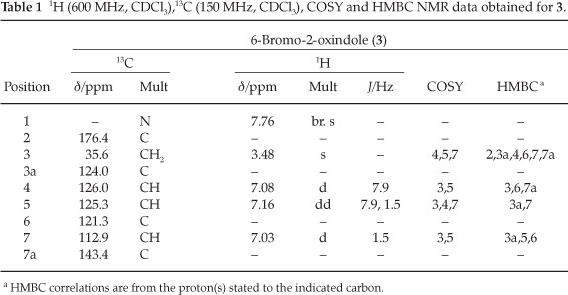
The oxindole 3 is commercially available21 and has also been detected, using GC/MS, in extracts of the marine murex snails Plicopurpura patula and Plicopurpura columellaris (Mollusca: Gastropoda).22 Once again, the presence of the same secondary metabolite in marine organisms from different phyla may indicate a bacterial source from which, in the case to the predatory murex snails, the metabolite is sequestered.18-20
As part of our on-going investigation of the cytotoxicity of South African marine invertebrate and algal natural products to various cancer cell lines, 1-3 were screened against the metastatic MDA-MB-231 breast cancer cell line.23,24 The IC50 values observed for 1-3 were 117.72 µM, 72.53 µM and 74.41 µM, respectively, indicating that these compounds are moderately cytotoxic to MDA-MB-231 breast cancer cells.
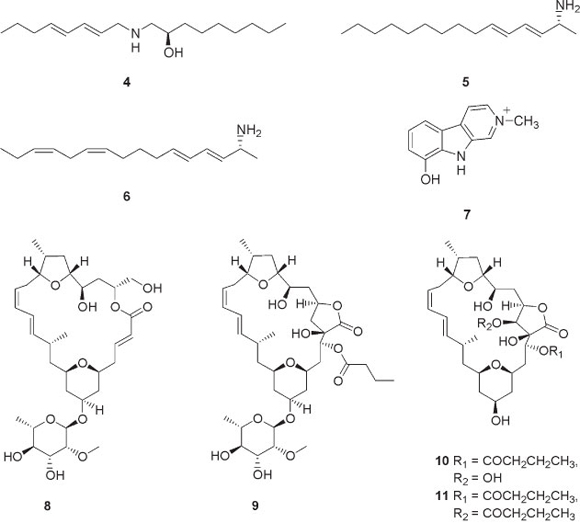
3. Conclusion
The isolation of 1-3 from Distaplia skoogi has added to our growing knowledge of the diverse secondary metabolites produced by the ascidians of Algoa Bay, South Africa. In addition to the halogenated indoles and 2-oxindole described here the cytotoxic unsaturated aliphatic amines 4-7 were isolated from the Algoa Bay ascidian Pseudodistoma sp. as part of an investiga-tionby the US National Cancer Institute from ascidians collected in Algoa Bay in 1998.25 More recently, a series of glycosylated polyketide macrolides, mandelalides A-D (8-11), with cytotoxic activity against human lung cancer cells, were obtained from a new species of Lissoclinum, collected from Algoa Bay.2 While the Algoa Bay ascidian Synoicum globosum Parker-Nance, 2012 afforded a group of new anti-microbial rubrolides, 12-17.27
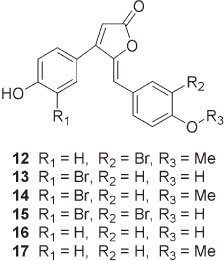
4. Experimental
4.1. General
Infra-red spectra were recorded on a Perkin-Elmer Spectrum 2000 FT-IR spectrometer and Digilab FTS 3100 Excalibur HE Series with compounds as films (neat) on KBr discs. NMR. spectra were acquired using standard pulse sequences on a Bruker Avance 600 MHz Avance II spectrometer. Chemical shifts are reported in ppm and referenced to residual solvent resonances (CDCl3 δH 7.26, δc 77.0). Coupling constants are reported directly from the NMR spectra. Mass spectrometry was performed on a Waters API Q-TOF Ultima instrument using electrospray ionization in the positive or negative ion mode (ES+, or ES-) at the University of Stellenbosch Central Analytical Facility. Normal phase DIOL semi-preparative HPLC separations were performed on a Machery-Nagel VP 250/10 Nucleosil 100-7 OH column using an Agilent 1100 Series quad pump and an Agilent 1100 diode array detector.
4.2. Animal Material
The colony of Distaplia skoogi Michaelsen, 1934 collected from a depth of 25 m at the White Sands Reef, Algoa Bay, South Africa (34:00.436S, 25:43.296E), on 15 July 2004, was identified by S. Parker-Nance. The voucher specimen (SAF2004-030), preserved in 5 % buffered formalin, is housed at the South African Institute for Aquatic Biodiversity (SAIAB), Grahamstown, South Africa. Samples of D. skoogi were frozen immediately after collection in the field and kept at -18 °C until extracted.
4.3. Extraction and Isolation
The frozen ascidian colony (309.41 g wet mass) was lyophilized and then sequentially extracted with 100 % MeOH followed by 100 % CH2Cl2. The combined organic extracts were concentrated in vacuo and then subjected to liquid-liquid partitioning between EtOAc and H2O. The combined EtOAc fractions were concentrated in vacuo to yield 1.11 g of extract. A 350 mg aliquot of the partitioned extract was purified further with normal phase HPLC (40 % EtOAc/hexane) on a semi-preparative DIOL column to afford four fractions. Fraction 2 was subjected to normal phase DIOL HPLC (60 % CH2Cl2/hexane) followed by further normal phase DIOL HPLC (20 % CH2Cl2/hexane) purification to yield 3.0 mg of 3,6-dibromoindole (1) and 2.2 mg of 6-bromo-3-chloroindole (2). Fraction 3 was further purified using a small DIOL plug (10 % EtOAc/hexane), and recrystal-lization from hexane to afford 2.4 mg of 6-bromo-2-oxindole (3) as colourless needles.
4.4. Characterization Data
3,6-Dibromoindole (1)
Colourless oil; IR (film) vmax 3445,1422,1265,1106,895,736 cm-1; 1H and 13C NMR data were consistent with published data;13 EIMS m/z 276 [(M-H)-] (48), 274 (100), 272 (49); HRESIMS m/z 271.8719 (calcd for C8H4N79Br2[(M-H)-], 271.8710, Δ 0.9 mDa).
6-Bromo-3-chloroindole (2)
Colourless oil; IR (film) vmax 3445, 3055, 1265, 895, 737 cm-1; 1H NMR (CDCl3,600 MHz) δ 8.08 (1H, br, s, NH), 7.53 (1H, d, J = 1.5 Hz, H-7), 7.50 (1H, d, J = 8.3 Hz, H-4), 7.30 (1H, dd, J = 8.3, 1.5 Hz, H-5), 7.16 (1H, d, J = 2.6 Hz, H-2); 13C NMR (CDCl3, 150 MHz) δ 135.7 (C, C-7a), 124.4 (C, C-3a), 123.9 (CH, C-5), 121.4 (CH, C-2), 119.7 (CH, C-4), 116.8 (C, C-6), 114.4 (CH, C-7), 107.0 (C, C-3); ESIMS m/z 232 [(M-H)-] (28), 230 (100), 228 (78); HRESIMS m/z 227.9215 (calcd for C8H4N79Br35Cl[(M-H)-], 227.9216, Δ 0.1 mDa).
6-Bromo-2-oxindole (3)
Colourless needles (hexane); mp 216-219 °C, lit.21 217-221°C; IR (film) vmax 3435,1643,1096 cm-1; 1H NMR (CDCl3, 600 MHz) δ 7.76 (1H, br, s, NH), 7.16 (1H, dd, J = 7.9,1.5 Hz, H-5), 7.08 (1H, d, J = 7.9 Hz, H-4), 7.03 (1H, d, J = 1.5 Hz, H-7), 3.48 (2H, s, H2-3); 13C NMR (CDCl3,150 MHz) δ 176.4 (C, C-2), 143.4 (C, C-7a), 126.0 (CH, C-4), 125.3 (CH, C-5), 124.0 (C, C-3a), 121.3 (C, C-6), 112.9 (CH, C-7), 35.6 (CH2, C-3); ESIMS m/z 215 [(M+H)+] (10), 214 (100), 213 (10), 212 (97); HRESIMS m/z 211.9710 (calcd for C8H7NO79Br[(M+H)+], 211.9711, Δ 0.1 mDa).
5. Bio-assay
MDA-MB-231 breast cancer cells (ATCC HTB-26) were cultured in Dulbecco's Modified Eagle Medium (DMEM) supplemented with 5 % (v/v) heat-inactivated FCS, 1 mM L-glutamine, 100 U/mL penicillin, 100 µg mL-1 streptomycin and 12.5µg mL-1 amphotericin (PSA) at 37 °C in a humidified 9 % CO2 incubator. The effect of the compounds on cell proliferation was assessed using the MTT iassay (Roche) as previously described.24 Cells were seeded at a density of 6000 cells per well into 96-well plates and incubated overnight, followed by treatment with a range of concentrations (0,0.5,5,50,250 and 500 µM) of the compounds or dimethyl sulphoxide (DMSO) vehicle control (0.02 % v/v DMSO) for 96 hours and absorbance at 595 nm recorded using a Powerwave spectrophotometer (BioTek). The half maximal inhibitory concentration (IC50) for each compound was calculated relative to the vehicle-treated control from a dose response curve (log concentration vs absorbance at 595 nm) using non-linear regression with GraphPad Prism 4 (GraphPad Inc.).
Paclitaxel was included as a positive control (IC50 of 100 nM). All treatments were conducted in triplicate on each of the two plates.24
Supplementary Material
The 1H (CDCl3, 600 MHz) and13C (CDCl3, 150 MHz) NMR spectra obtained for compounds 1-3 are available in the online supplement.
Acknowledgements
The authors thank Professor Bill Fenical of Scripps Institution of Oceanography, San Diego, USA, for the generous donation of funding which enabled the first large-scale SCUBA collection of marine ascidians in Algoa Bay, South Africa. Financial support from Rhodes University and the National Research Foundation through the Sea Change Programme is gratefully acknowledged.
References and Notes
1 J.W. Blunt, B.R. Copp, R.A. Keyzers,M.H.G.MunroandM.R. Prinsep, Nat. Prod. Rep., 2012, 29, 144-222. [ Links ]
2 A.M.S Mayer, K.B. Glaser, C. Cuevas, R.S. Jacobs, W. Kem, R.D. Little, J.M. McIntosh, D.J. Newman, B.C. Potts and D.E. Shuster, Trends Pharmacol. Sci., 2010, 31, 255-265. [ Links ]
3 European Science Foundation, Marine Biotechnology, 2010, 15, 44-81. [ Links ]
4 R. Montaser and H. Luesch, Future Med. Chem, 2011, 3, 1475-1489. [ Links ]
5 T.F. Molinski, D.S. Dalisay, S.L. Lievens and J.P. Saludes, Nat. Rev. Drug Discov, 2009, 8, 69-85. [ Links ]
6 C. Monniot, F. Monniot, C.L. Griffiths and M. Schleyer, Ann. S. Afr. Mus, 2001, 108, 1-1417. [ Links ]
7 W. Michaelsen, Trans. Roy. Soc. S. Afr., 1934, 22, 126-163. [ Links ]
8 K. Sink, S. Holness, L. Harris, P. Majiedt, L. Atkinson, T. Robinson, S. Kirkman, L. Hutchings, R. Leslie, S. Lamberth, S. Kerwath, S. von der Heyden, A. Lombard, C. Attwood, G. Branch, T. Fairweather, S. Taljaard, S. Weerts, P. Cowley, A. Awad, B. Halpern, H. Grantham, and T. Wolf, National Biodiversity Assessment 2011: Technical Report, South African National Biodiversity Institute, Pretoria, 2012, 4, pp 325. [ Links ]
9 S. Parker-Nance, Aplousobranch ascidians (Tunicata: Ascidiacea) from southern Africa., PhD thesis, University of Port Elizabeth, Port Elizabeth, South Africa, 2003. [ Links ]
10 A.A. Awad, C.L. Griffiths and J.K. Turpie, Divers. Distrib., 2002, 8, 129-145. [ Links ]
11 M.J. Gibbons, B.B. Abiahy, M. Angel, C.M.L. Assuncao, I.Bartsch, P. Best, R. Biseswar, J. Bouillon, J.M. Bradford-Grieve, W. Branch, E. Burreson, L. Cannon, J.-P. Casanova, A. Channing, C.A. Child, L. Compagno, P.F.S. Cornelius, J.R. Dadon, J.H.M. David, J. Day, N. Della Croce, P. Emschermann, C. Erseus, G. Esnal, R. Gibson, C.L. Griffiths, P.J. Hayward, R. Heard, P. Heemstra, D. Herbert, R. Hessler, R. Higgins, N. Hiller, Y.M. Hirano, B. Kensley, R. Kilburn, L. Kornicker, J. Lambshead , R. Manning, D. Marshall, H. Mianzan, C. Monniot, F. Monniot, W. Newman, C. Nielsen, G. Patterson, P. Pugh, M. Roeleveld, A. Ross, P. Ryan, J.S. Ryland, T. Samaai, M. Schleyer, E. Schockaert, R. Seapy, R. Shiel, R. Sluys, E.C. Southward, A. Sulaiman, A. Thandar, J. van der Land, S. van der Spoel, R. van Soest, E. Vetter, G. Vinogradov, G. Williams and T. Wooldridge, S. Afr. J. Sci., 1999, 95, 8-12. [ Links ]
12 C.L. Griffiths, T.B. Robinson, L. Lange and A. Mead, PLoS ONE, 2010, 5(8), 1-13. [ Links ]
13 A. Qureshi and D.J. Faulkner, Nat. Prod. Lett, 1999, 13, 59-62. [ Links ]
14 P. Crews, J. Rodriguez and M. Jaspars, Organic Structure Analysis, (K.N. Houk and G.M. Loundon, eds.), 2nd edn, Oxford University Press, New York, Oxford, 2010, pp. 364-374. [ Links ]
15 T. Higa, T. Fujiyama and P.J. Scheuer, Comp. Biochem. Physiol., 1980, 65B, 525-530. [ Links ]
16 C.B. Cameron, J.R. Garey and B.J. Swalla, PNAS, 2000, 97(9), 4469-4474. [ Links ]
17 B.J. SwallaandA.C. Smith, Phil. Trans. R. Soc. B.,2008, 363,1557-1568. [ Links ]
18 M.G. Haygood, E.W. Schmidt, S.K. Davidson and D.J. Faulkner, J. Molec. Microbiol. Biotechnol, 1999, 1(1), 33-43. [ Links ]
19 E.W. Schmidt and M.S. Donia, Curr. Opin. Biotechnol., 2010, 21(6), 827-833. [ Links ]
20 E.W. Schmidt, M.S. Donia, J.A. McIntosh, W.F. Fricke and J. Ravel, J. Nat. Prod., 2012, 75, 295-304. [ Links ]
21 6-Bromo-2-oxindole is commercially available from Sigma Aldrich®, CAS number [99365-40-9]. [ Links ]
22 F.J. López Chávez, P. Rios Chávez and K. Oyama, Dyes Pigments, 2009, 83, 7-13. [ Links ]
23 C.E. Whibley, R.A. Keyzers, A.G. Soper, M.T. Davies-Coleman, T. Samaai and D.T. Hendricks, Ann. N.Y. Acad. Sci., 2005, 1056, [ Links ]
24 J. de la Mare, J.C. Lawson, M.T. Chiwakata, D.R. Beukes, A.L. Edkins, G.L. Blatch, Invest. New Drugs, 2012, 30, 2187-2200. [ Links ]
25 M.A. Rashid, K.R. Gustafson, L.K. Cartner, L.K. Pannell and M.R. Boyd, Tetrahedron, 2001, 57, 5751-5755. [ Links ]
26 J. Sikorska, A.M. Hau, C. Anklin, S. Parker-Nance, M.T. Davies-Coleman, J.E. Ishmael and K.L. McPhail, J. Org. Chem., 2012, 77, 6066-6075. [ Links ]
27 J. Sikorska, S. Parker-Nance, M.T. Davies-Coleman, O.B. Vining, A.E. Sikora and K.L. McPhail, J. Nat. Prod., 2012, 75, 1824-1827. [ Links ]
Received 13 November 2012
Revised 29 January 2013
Accepted 8 February 2013
* To whom correspondence should be addressed. E-mail: clbromley@gmail.com
Supplementary Data
Figure S1 1H (CDCl3, 600 MHz) NMR spectrum obtained for 1..................S2
Figure S2 13C (CDCl3, 150 MHz) NMR spectrum obtained for 1..................S2
Figure S3 1H (CDCl3, 600 MHz) NMR spectrum obtained for 2...................S3
Figure S4 13C (CDCl3, 150 MHz) NMR spectrum obtained for 2..................S3
Figure S5 1H (CDCl3, 600 MHz) NMR spectrum obtained for 3...................S4
Figure S6 13C (CDCl3, 150 MHz) NMR spectrum obtained for 3..................S4
